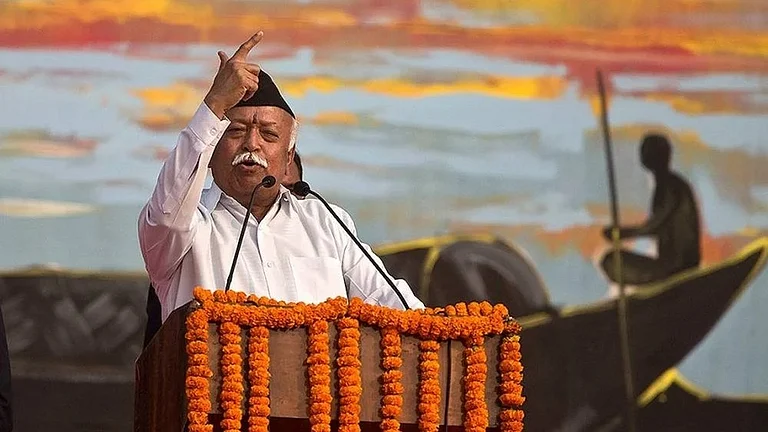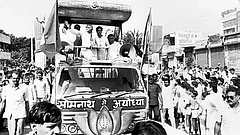What does a Hindu Rashtra look like? How far are we from it? Or how deep are we already into the Hindu Rashtra, now that the Ram temple is being inaugurated on that once-disputed Ayodhya land with full state patronage?
Such questions have plagued many minds, as reflected in various social media posts, in recent months.
In June 2012, about a dozen functionaries of various organisations affiliated with the Rashtriya Swayamsevak Sangh (RSS), the parent organisation of India’s ruling Bharatiya Janata Party (BJP), attended a conference in Goa to discuss establishing a Hindu Rashtra in India. The Akhil Bharatiya Hindu Rashtra Adhiveshan was the first such event—a national conference—for the establishment of such a Rashtra.
During the conference, Hindutva ideologue Charudatta Pingale gave a picture of the Hindu Rashtra as he conceived it. From incorporating a “subtle dimension in judicial process” to rewriting Indian history, his depiction of a Hindu Rashtra covered almost every aspect of public and even private life.
According to him, the laws in the Hindu Rashtra will look after Hindu interests. Religious conversions will be banned. Policemen will be devoted to the nation and Dharma. There will be no reservations. There will not be any strikes, protests or rallies. Farmers will produce only those goods that aid national progress. Strong laws will be passed to check infiltration and the borders will be secured. Economic policies would be based on Kautilya’s wisdom and the pivotal point of societal well-being would be Dharma, not law.
Organised by the Goa-based rightwing Hindu organisation Sanatan Sanstha (SS) and its affiliate, the Hindu Janajagruti Samiti (HJS), it saw the attendance of a galaxy of Hindutva leaders and Hindu organisations from different parts of the country.
The SS and HJS claim to be outside the Sangh Parivar, but maintain relations with several RSS family organisations. While former Union Minister Subramanian Swamy, a prominent face of the Sangh Parivar, did not attend the meet in person, his message congratulating the organisers, stressed the need for “a war of independence again.”
Attendees for the event were drawn from top Sangh Parivar and allied Hindutva outfits, including the Vishwa Hindu Parishad’s Delhi unit general secretary Satyendra Mohan and Suryakant Kelkar, an RSS full-timer.
Pingale envisions the Hindu Rashtra with an ideal gurukul education system, introducing Dharma education from school. Schools will teach history, fostering devotion and warrior temperament. Public places will bear the names of deities, saints, and sages. Ayurveda gains official status, promoting satvik food. Temple management will be entrusted to genuine devotees as governments step back.
The conclave prioritised cow protection, emphasising the creation of village-level cow protection squads to monitor roads, prevent ‘trafficking’ of cows, and liberate them. Lawyers were urged to actively secure the release of detained squad members. In his message, Sri Sri Ravi Shankar of the Art of Living Foundation—who did not attend in person but sent a representative and a written message—too, stressed the “need to deliberate on issues like cow slaughter and protection of temples.”
The Conclave’s resolutions included expelling ‘five crore Bangladeshi infiltrators’, enforcing a Uniform Civil Code, ending sectarian reservations, rejecting the Sachar Committee report on the status of minorites, eliminating special rights for religious minorities, imposing life imprisonment for religious conversions, and nationwide laws against cow slaughter.
Resolutions involved renaming schemes after saints and national heroes, rechristening those linked to the Gandhi-Nehru clan. Mockery of Hindu texts and distortion of history were designated as serious offences, requiring cognizable and non-bailable charges.
The Sangh Parivar or the RSS family of organisations doesn’t necessarily subscribe to all these features dished out at the conclave as the essentials of a Hindu Rashtra.
The Sangh Parivar began distancing itself from the Hindu Rashtra Adhiveshan in 2016. The distancing was possibly because the RSS did not want to be dictated by the smaller Hindutva organisations.
Since 2014, RSS head Mohan Bhagwat has asserted that India has always been a Hindu Rashtra, emphasising the need for recognition. In 2023, he urged people to refer to the country as Bharat as part of acknowledging its inherent identity.
Hindu Rashtra stands on the principle of “satya, karuna, shuchita and tapas” (truth, compassion, honesty and rigour), which is why it could not be oppressive to anyone, Bhagwat said in his Vijaya Dashami speech in September 2023.
“When The First Adhiveshan Of Hindu Rashtra Was Held 10 Years Ago, Everyone Looked At The Term Hindu Rashtra With Scepticism. Today, It Has Become Prevalent”.
What cannot be dismissed, though, is that several issues highlighted and resolutions adopted at the Hindu Rashtra Adhiveshan have already seen the light of reality in the past nine-and-a-half years of Prime Minister Narendra Modi’s nationalist regime.
As the first step towards deporting “illegal infiltrators” through an Assam-style National Register of Citizens (NRC), the Citizenship Amendment Act (CAA) has been enacted, though not yet implemented as its rules are yet to be framed. While yet to be implemented, the BJP plans to introduce the Uniform Civil Code in Uttarakhand in January 2024. The imprinting of Hindutva on the national consciousness has accelerated notably.
Arrests for allegedly hurting Hindu sentiments have risen, especially in BJP-ruled states like Gujarat, Uttar Pradesh, Haryana, Maharashtra, Sikkim, and Madhya Pradesh. Stringent amendments or new laws on anti-cow slaughter have been introduced, contributing to frequent news coverage of cow vigilantism and the lynch mobs it tends to incite.
The parliamentary reservation to the Anglo-Indian community—who are predominantly Christian—has been removed.
Besides, as many as 12 of India’s 28 states now have anti-conversion laws. In seven states—Gujarat, Haryana, Himachal Pradesh, Karnataka, Madhya Pradesh, Uttarakhand and Uttar Pradesh—individuals accused of violating an anti-conversion law are mandated to prove their innocence.
Despite retracting its stance on reservation abolition, the RSS advocates for a national policy on population control. Bhagwat contends that the policy should tackle demographic imbalances arising from “forced religious conversions due to lure, greed, and illegal infiltration across the borders.”
The Hindutva camp celebrated success at the 2022 Hindu Rashtra Adhiveshan, labelling it the Vijaya Dashmi of the Hindu Rashtra. Organisers declared the event, the end of Hindu repression, predicting the emergence of the ‘Hindu Rashtra’ by 2025.
The conference demanded the immediate enactment of the CAA, proposed a separate Union Territory called Panun Kashmir for displaced Kashmiri Hindus, suggested replacing ‘secular’ and ‘socialist’ in the Constitution with ‘spiritual’, and called for the repeal of the 1991 Places of Worship Act, potentially opening avenues for reclaiming various temple sites, including those at Mathura and Kashi.
“When the first Adhiveshan of Hindu Rashtra was held 10 years ago, everyone looked at the term Hindu Rashtra with scepticism. Today, it has become prevalent,” said Sunil Ghanwat, HJS organiser from Maharashtra and Chhattisgarh. He cited campaigns like Puri Shankaracharya’s ‘Hindu Rashtra Sangh’, Kashi Vidvat Parishad’s ‘Sanskruti Sansad’ and ‘Save Temples’ and ‘Reclaim Temples’ in South India that would take India closer to Hindu Rashtra.
MORE FROM THIS ISSUE
(This appeared in the print as 'Mapping The March')


















.jpg?auto=format%2Ccompress&fit=max&format=webp&w=376&dpr=2.0)













